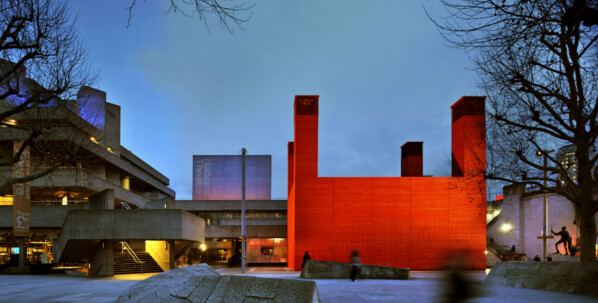Part building, part installation, part event – The Shed
A temporary theatre space situated on London’s South Bank, is the result of a collaborative process that merged the opportunity to explore new ways of making theatre with the chance to experiment with architectural design. A JCT Intermediate Building Contract took centre stage.
The Shed is a one-year temporary theatre built to provide the National Theatre with a third space whilst the Cottesloe Theatre (the smallest of the NT’s three auditoriums) is closed for redevelopment. It cost £1.2m to build and has a seating capacity of 225. The entire project took little over a year to complete, with the construction phase running from September 2012 to February 2013.
The National Theatre engaged with architects Haworth Tompkins and theatre consultants CharcoalBlue in the conception of The Shed. Haworth Tompkins had experience with very similar types of temporary theatre projects, including the Almeida Theatre’s spaces at Gainsborough Studios and King’s Cross. In addition, the main contractor, Rise Contracts, was also well placed with experience on a number of high profile projects, including Lord’s Cricket Ground and the headquarters of the Football Association (FA). Rise Contracts are also currently working on building projects for the Young Vic and work on the National Theatre Studios.
Completing The Shed involved the project team, including the designers, contractor, and the theatre-makers who would be working with the completed project, working closely together. With its temporary nature, creativity, and fluid collaboration, the building process resembled as much a live theatre event as a construction project.
This collaboration is reflected in the reception The Shed has received from both the construction and theatre communities since its opening. Already, The Shed has picked up ‘The Temporary’ category prize at the New London Awards 2013, which celebrates the Capital’s best architecture, planning and development, as well as the Gold Medal at this year’s German Design Awards. In addition, The Shed was also named the Empty Space Peter Brook Award winner because of its adventurous and experimental programme.
The location of The Shed is key to its design and function. Situated in front of, and connected to the National Theatre, its stark and simple features, raw steel and plywood construction, and rough-sawn timber cladding evoke the concrete, brutalist form of the National Theatre itself. However its distinctive castle shape and bold red colour achieves a contrasting and iconoclastic presence.
The Shed is made from 100% recycled materials (which will in fact be recycled once the building is taken down) and is naturally ventilated by pulling air through the four tower structures. Many of the materials, such as the lighting and seating were sourced and re- used by the client themselves. All timber was FSC sourced. A temporary foyer was carved from the space beneath the National Theatre’s existing external terrace which also provides access to the other foyers on the complex. The venue contains its own bar, espresso bar and box office.
The Shed is a distinctive project which both stretches the definition of, and cleverly encompasses London’s current trend for ‘pop-up’ style venues, including the Box Park retail venue in Shoreditch and the KERB street food collective in Maida Hill Place. However in exploring the concept of what a temporary venue can be, traditional building is found to be a crucial element and very much at the heart of the The Shed.
The JCT Intermediate Building Contract offers a contractual solution that encapsulates the parties’ vision, embraces collaborative spirit and a fluid working methodology, but also has the flexibility to be used when the line between temporary, installation art and traditional construction is blurred. In the case of The Shed, it has helped pull off quite a performance.
A video including explaining the concept, design and construction process of The Shed can be found on the architect’s website: http://www.haworthtompkins.com/built/proj41/index.html, or on YouTube.
Image: Philip Vile

